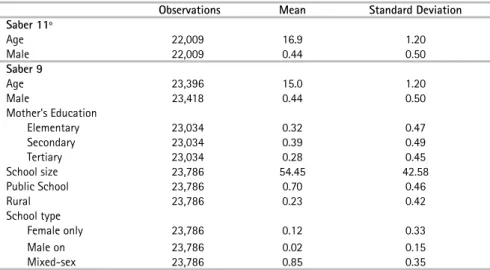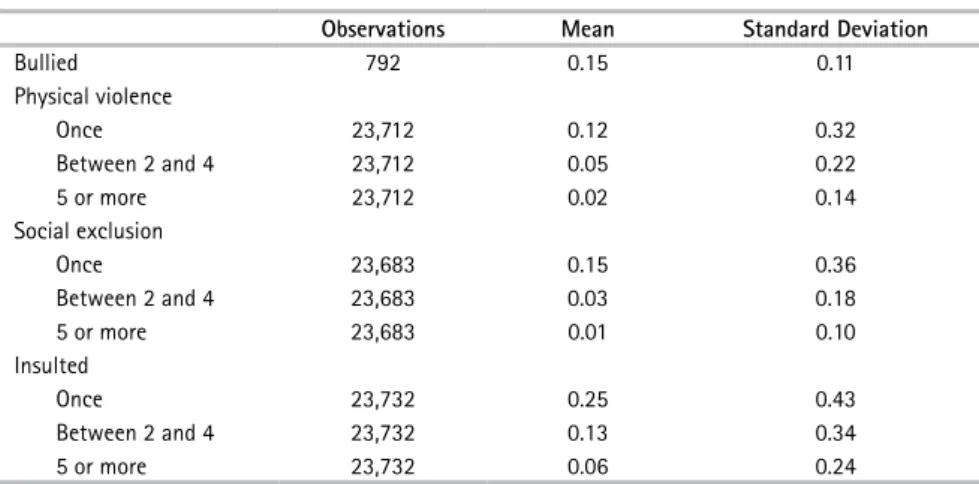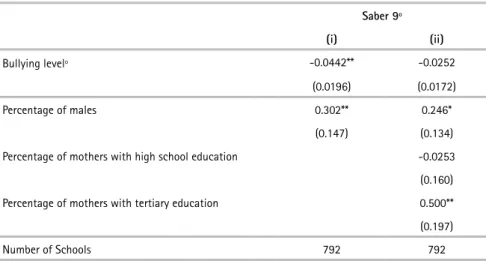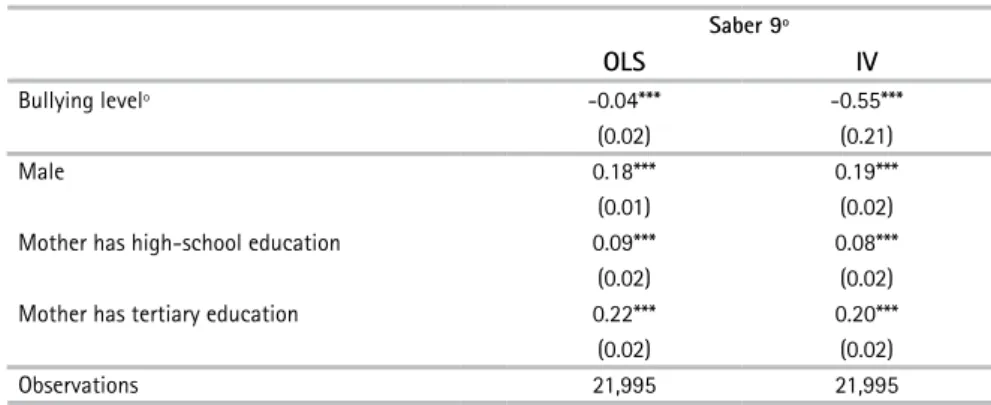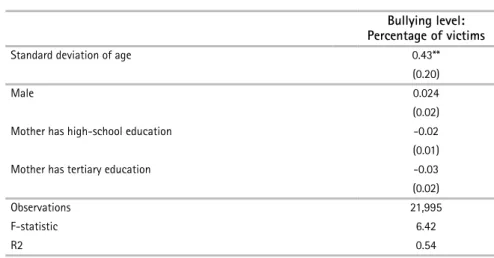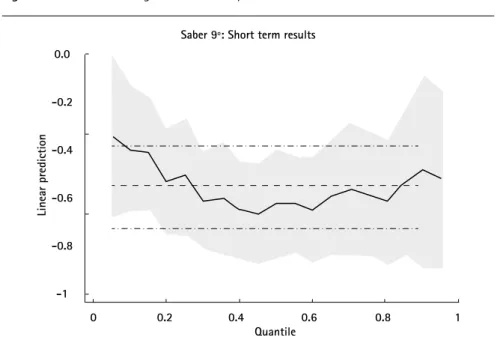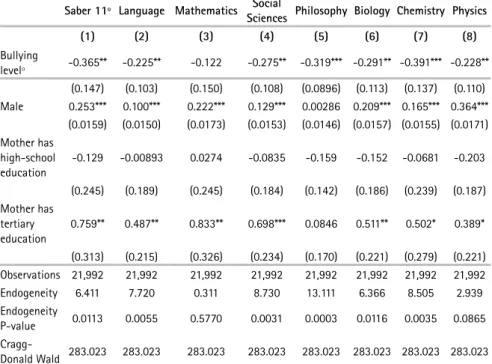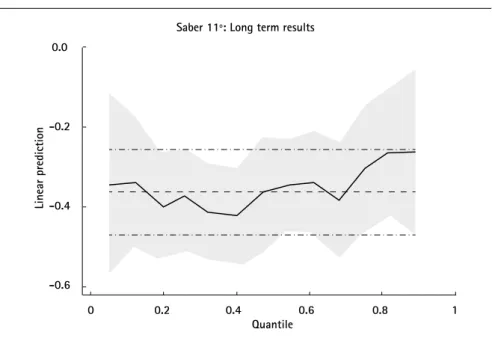This paper analyzes the effect of bullying on student performance in the short and long term. The level of bullying is assessed by the responses of 9th grade students on the Saber test, while student performance is measured on both the Saber 9º test (short-term) and the Saber 11º test, a standardized test answered by students two years later (long-term). . Furthermore, this paper finds that there are differences in the relationship between the level of bullying and academic performance depending on the student's academic achievement.
This paper contributes to the existing literature by analyzing the effect of the school level of bullying on student achievement in the short and long term. The level of bullying is estimated from the answers of 9th grade students in Saber test while students' performance is measured in both Saber 9º test (short term) and Saber 11º, a standardized test administered by students two years later (long term) be answered. .7 The estimate takes into account both the existence of additional variables that determine the level of bullying and academic performance, and the existence of reverse causality.
Furthermore, this paper finds that there are differences in the relationship between the level of bullying and academic performance depending on the student's academic performance.
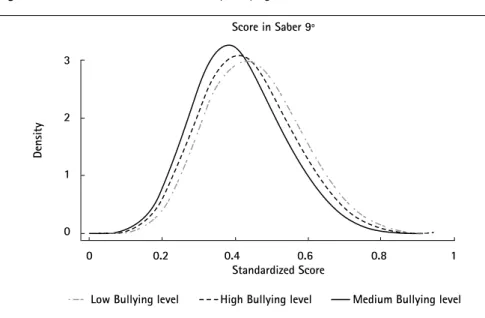
Data
A second way in which bullying can negatively impact performance is through lower peer effects, because, according to Brown and Taylor (2008), victims have fewer friends and poorer relationships with their peers and therefore fewer opportunities to learn from them. Regarding the institutional characteristics that explain the negative effect of bullying, it is important to recognize that in schools where bullying is prevalent, the classroom climate hinders learning because students live in an environment of teasing, stress and anger, all of which have a have a negative impact on their behavior. ability to learn (Chaux, 2012). Furthermore, this type of environment reduces students' motivation and prevents students from participating and asking questions in class because they are afraid of their classmates' reaction.
Although international evidence posits the existence of a negative relationship between the level of bullying and the academic performance of both developed and developing countries, according to the above finding, this article contributes to the literature as it quantifies the relationship between these variables after controlling by the existence of reverse causality. In this sense, the article contributes to the literature by estimating the relationship without the negative bias in the magnitude of the effect that comes from bullying targeting students depending on their academic performance in a developing country.
Content Knowledge Tests: Saber 9º and Saber 11º
During the test, freshmen answered 12 questions in each area, which add up to a total of 48 questions from which an individual average knowledge score was constructed and then standardized so that its mean is zero and the deviation standard one. It is important to mention that there were three questionnaires in this test, but the results are only available for two of the three questionnaires. Additionally, individual scores for the content knowledge component of a limited sample that includes specific probing questions—explained in detail in the next section—are not available.
Two years later, in the second semester of 2007 and the first semester of 2008, the same group of students underwent a second test called Saber 11º. This test is an official requirement that all seniors must pass to graduate from high school; its main objective is to measure the abilities of senior students in order to provide universities and other tertiary education institutions with a measure of each individual's abilities in seven different areas. It is important to note that, although students from the same groups took this second test, since there is no name data in Saber 9º, it is impossible to know whether some students dropped out, completed high school in a other. institution, or if there are new students in existing schools.
An important note in interpreting the results is that since the average score of Saber 11º varies between semesters, the test results are standardized per semester so that they are comparable: the average score of each area and the overall score is zero and the standard deviation is a.
Bulling Level
Regarding the bullying level, the test measures the level of aggression within the school by asking students about the number of insults they have experienced, the number of times they have been beaten and the number of times they have been excluded by their classmates in the past. week. Some people often feel very bad because they are often beaten or insulted by others. At first they took his food, then they started stealing and damaging his things and now they beat him and tease him.
To measure the incidence of bullying, the questionnaire asked each student if they had been beaten or bullied and felt helpless like Marcos during the past two months; if they had seen situations like those in their classroom; or, if they had acted like Fanny and Gabriel during the same time period. Based on the information above, it is possible to determine whether each student was bullied, bullied another, both, or neither. However, since there is no data on each student's name, it is impossible to match that data to individual test scores, meaning that the results can only be used to determine the effect of bullying on academic achievement at the overall level. .
It also indicates that the most common source of aggression among first-year students is insults, followed by similar levels of physical violence and social exclusion. It is worth mentioning that, as mentioned earlier, the level of bullying was only measured in the first questionnaire of the citizenship competences module and thus it is only possible to measure it at school level. In addition, because there are no individual measures of aggression in Saber 11º, long-term aggression levels are measured by the percentage of children who have been insulted, hit or excluded one or more times in Saber 9º.
Individual-, household-, and school-level characteristics A discrete age variable is used to both control for student age and to calculate
Individual, Household, and School Level Characteristics A discrete age variable is used both to control by student’s age and to cal-
- Methodology
- Short Term Results: Bullying Effects Over Saber 9º
- Long Run Results: Bullying Effect Over Saber 11º
- Conclusions
To measure the impact of the average level of bullying in each school on average academic achievement in the short run, we run form regressions. Finally, it is worth noting that, as neighborhood violence increases, so does violence within schools. The effect of the level of bullying on average academic achievement in the long term is estimated through regressions of this form.
14 In the long run, there is no individual information on mother's education, income level, or level of aggression experienced by each student, and these variables are included only as averages across schooling levels. Therefore, an increase in the standard deviation of age results in a greater number of older students who can bully their younger and weaker peers. This is particularly important because it provides an opportunity to analyze whether the effect of bullying is particularly perverse for those students in the right tail of the achievement distribution or if the effect is greater for those in the left tail.
Taking the above into account, Table 4 assesses the effects of the level of bullying at school on an individual's short-term academic performance as measured by the Saber 9º test. The results also indicate a negative bias in the effect of bullying on the relationship between bullying levels and academic achievement, with the victims of bullying being high-ability students with better scores on the Saber 11ºth test and those who were likely to get better grades throughout their time in school. They show that a one standard deviation increase in the percentage of school bullying victims decreases Saber 11º test scores by 0.37 standard deviations.
An interesting finding is that the effect sizes are smaller than in the short term, a result that probably comes from the increased time interval between the intimidation episode and the state exam. The results show that for high school students in Colombia, the increased frequency of bullying negatively affects individual academic performance in both the short and long term. In particular, accounting for potential bias, a one standard deviation increase in the mean level of bullying lowers a student's Saber 9º test score by 0.55 standard deviations and their Saber 11º test score by 0.37 standard deviations.
This means that reducing the level of bullying in classrooms would not only improve students' performance on the Saber 9º and Saber 11º tests, but also improve their future wages and living conditions. Finally, this analysis reveals the existence of differences in the relationship between the level of bullying experienced and academic performance according to test scores over time. In particular, he notes that in the short term the effect of bullying is greater for students between the 30th and 90th percentile of the academic achievement distribution, but in the long term it is greater for those students below the median.
In addition, to more accurately assess the effect of bullying in the future, it would be interesting to measure the effect of different types of bullying.
